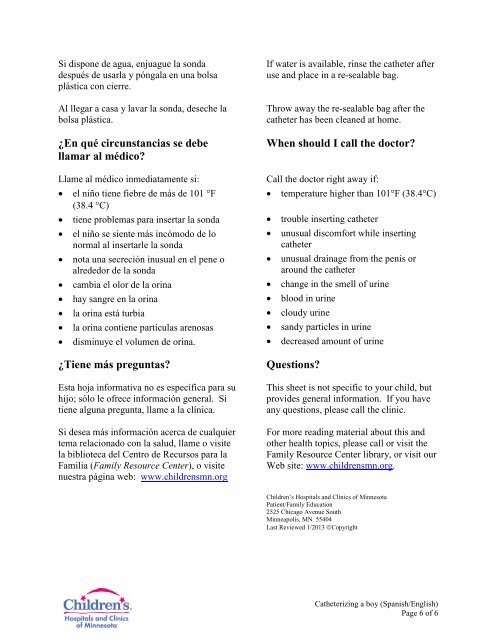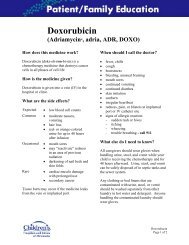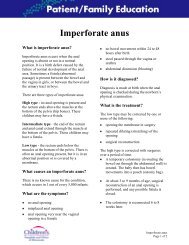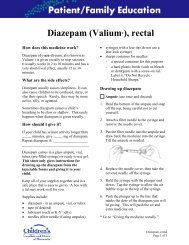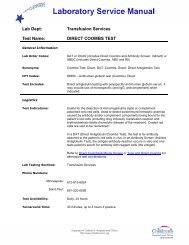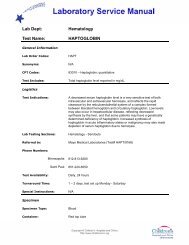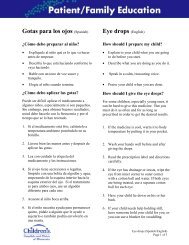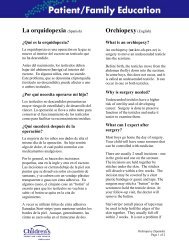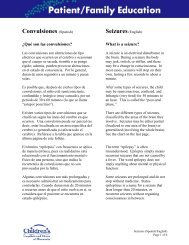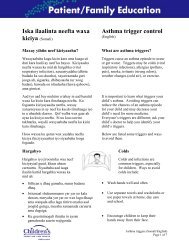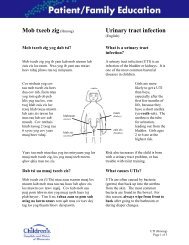El sondaje vesical intermitente en los niños Catheterizing a boy ...
El sondaje vesical intermitente en los niños Catheterizing a boy ...
El sondaje vesical intermitente en los niños Catheterizing a boy ...
Create successful ePaper yourself
Turn your PDF publications into a flip-book with our unique Google optimized e-Paper software.
Si dispone de agua, <strong>en</strong>juague la sonda<br />
después de usarla y póngala <strong>en</strong> una bolsa<br />
plástica con cierre.<br />
Al llegar a casa y lavar la sonda, deseche la<br />
bolsa plástica.<br />
¿En qué circunstancias se debe<br />
llamar al médico?<br />
Llame al médico inmediatam<strong>en</strong>te si:<br />
• el niño ti<strong>en</strong>e fiebre de más de 101 °F<br />
(38.4 °C)<br />
• ti<strong>en</strong>e problemas para insertar la sonda<br />
• el niño se si<strong>en</strong>te más incómodo de lo<br />
normal al insertarle la sonda<br />
• nota una secreción inusual <strong>en</strong> el p<strong>en</strong>e o<br />
alrededor de la sonda<br />
• cambia el olor de la orina<br />
• hay sangre <strong>en</strong> la orina<br />
• la orina está turbia<br />
• la orina conti<strong>en</strong>e partículas ar<strong>en</strong>osas<br />
• disminuye el volum<strong>en</strong> de orina.<br />
¿Ti<strong>en</strong>e más preguntas?<br />
Esta hoja informativa no es específica para su<br />
hijo; sólo le ofrece información g<strong>en</strong>eral. Si<br />
ti<strong>en</strong>e alguna pregunta, llame a la clínica.<br />
Si desea más información acerca de cualquier<br />
tema relacionado con la salud, llame o visite<br />
la biblioteca del C<strong>en</strong>tro de Recursos para la<br />
Familia (Family Resource C<strong>en</strong>ter), o visite<br />
nuestra página web: www.childr<strong>en</strong>smn.org<br />
If water is available, rinse the catheter after<br />
use and place in a re-sealable bag.<br />
Throw away the re-sealable bag after the<br />
catheter has be<strong>en</strong> cleaned at home.<br />
Wh<strong>en</strong> should I call the doctor?<br />
Call the doctor right away if:<br />
• temperature higher than 101°F (38.4°C)<br />
• trouble inserting catheter<br />
• unusual discomfort while inserting<br />
catheter<br />
• unusual drainage from the p<strong>en</strong>is or<br />
around the catheter<br />
• change in the smell of urine<br />
• blood in urine<br />
• cloudy urine<br />
• sandy particles in urine<br />
• decreased amount of urine<br />
Questions?<br />
This sheet is not specific to your child, but<br />
provides g<strong>en</strong>eral information. If you have<br />
any questions, please call the clinic.<br />
For more reading material about this and<br />
other health topics, please call or visit the<br />
Family Resource C<strong>en</strong>ter library, or visit our<br />
Web site: www.childr<strong>en</strong>smn.org.<br />
Childr<strong>en</strong>’s Hospitals and Clinics of Minnesota<br />
Pati<strong>en</strong>t/Family Education<br />
2525 Chicago Av<strong>en</strong>ue South<br />
Minneapolis, MN 55404<br />
Last Reviewed 1/2013 ©Copyright<br />
<strong>Catheterizing</strong> a <strong>boy</strong> (Spanish/English)<br />
Page 6 of 6


